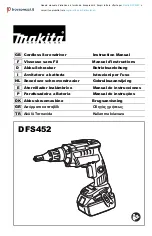
7
Indicating the remaining battery capacity (Fig. 6)
Only for battery cartridges with the indicator
Press the check button on the battery cartridge to
indicate the remaining battery capacity. The indicator
lamps light up for few seconds.
015658
NOTE:
• Depending on the conditions of use and the ambient
temperature, the indication may differ slightly from the
actual capacity.
Reversing switch action (Fig. 7)
CAUTION:
• Always check the direction of rotation before operation.
• Use the reversing switch only after the tool comes to a
complete stop. Changing the direction of rotation
before the tool stops may damage the tool.
This tool has a reversing switch to change the direction
of rotation. Move the reversing switch lever to the
position (A side) for clockwise rotation or the
position
(B side) for counterclockwise rotation.
When the reversing switch lever is in the neutral position,
the switch trigger cannot be pulled.
CAUTION:
• When not operating the tool, always set the reversing
switch lever to the neutral position.
Depth adjustment (Fig. 8 & 9)
The depth can be adjusted by turning the locator. Turn it
in “B” direction for less depth and in “A” direction for more
depth. One full turn of the locator equals 2 mm change in
depth.
Adjust the locator so that the distance between the tip of
the locator and the screw head is approximately 3 mm as
shown in the figures. Drive a trial screw into your material
or a piece of duplicate material. If the depth is still not
suitable for the screw, continue adjusting until you obtain
the proper depth setting.
Hook (Fig. 10)
CAUTION:
• Always remove the battery when hanging the tool with
the hook.
• Never hook the tool at high location or on potentially
unstable surface.
The hook is convenient for temporarily hanging the tool.
ASSEMBLY
CAUTION:
• Always be sure that the tool is switched off and the
battery cartridge is removed before carrying out any
work on the tool.
Installing or removing the bit (Fig. 11 & 12)
To remove the bit, pull the locator. Then grasp the bit with
a pair of pliers and pull the bit out of the magnetic bit
holder. Sometimes, it helps to wiggle the bit with the
pliers as you pull.
To install the bit, push it firmly into the magnetic bit
holder. Then install the locator by pushing it firmly back.
Hook (Fig. 13)
The hook is convenient for temporarily hanging the tool.
This can be installed on either side of the tool.
To install the hook, insert it into a groove in the tool
housing on either side and then secure it with a screw. To
remove, loosen the screw and then take it out.
OPERATION
Screwdriving operation (Fig. 14)
Fit the screw on the point of the bit and place the point of
the screw on the surface of the workpiece to be fastened.
Apply pressure to the tool and start it. Withdraw the tool
as soon as the clutch cuts in. Then release the switch
trigger.
CAUTION:
• When fitting the screw onto the point of the bit, be
careful not to push in on the screw. If the screw is
pushed in, the clutch will engage and the screw will
rotate suddenly. This could damage a workpiece or
cause an injury.
• Make sure that the bit is inserted straight in the screw
head, or the screw and/or bit may be damaged.
MAINTENANCE
CAUTION:
• Always be sure that the tool is switched off and the
battery cartridge is removed before attempting to
perform inspection or maintenance.
• Never use gasoline, benzine, thinner, alcohol or the
like. Discoloration, deformation or cracks may result.
To maintain product SAFETY and RELIABILITY, repairs,
carbon brush inspection and replacement, any other
maintenance or adjustment should be performed by
Makita Authorized Service Centers, always using Makita
replacement parts.
Indicator lamps
Remaining
Capacity
Lighted
Off
Blinking
75% to 100%
50% to 75%
25% to 50%
0% to 25%
Charge the
battery.
The battery may
have
malfunctioned.








































